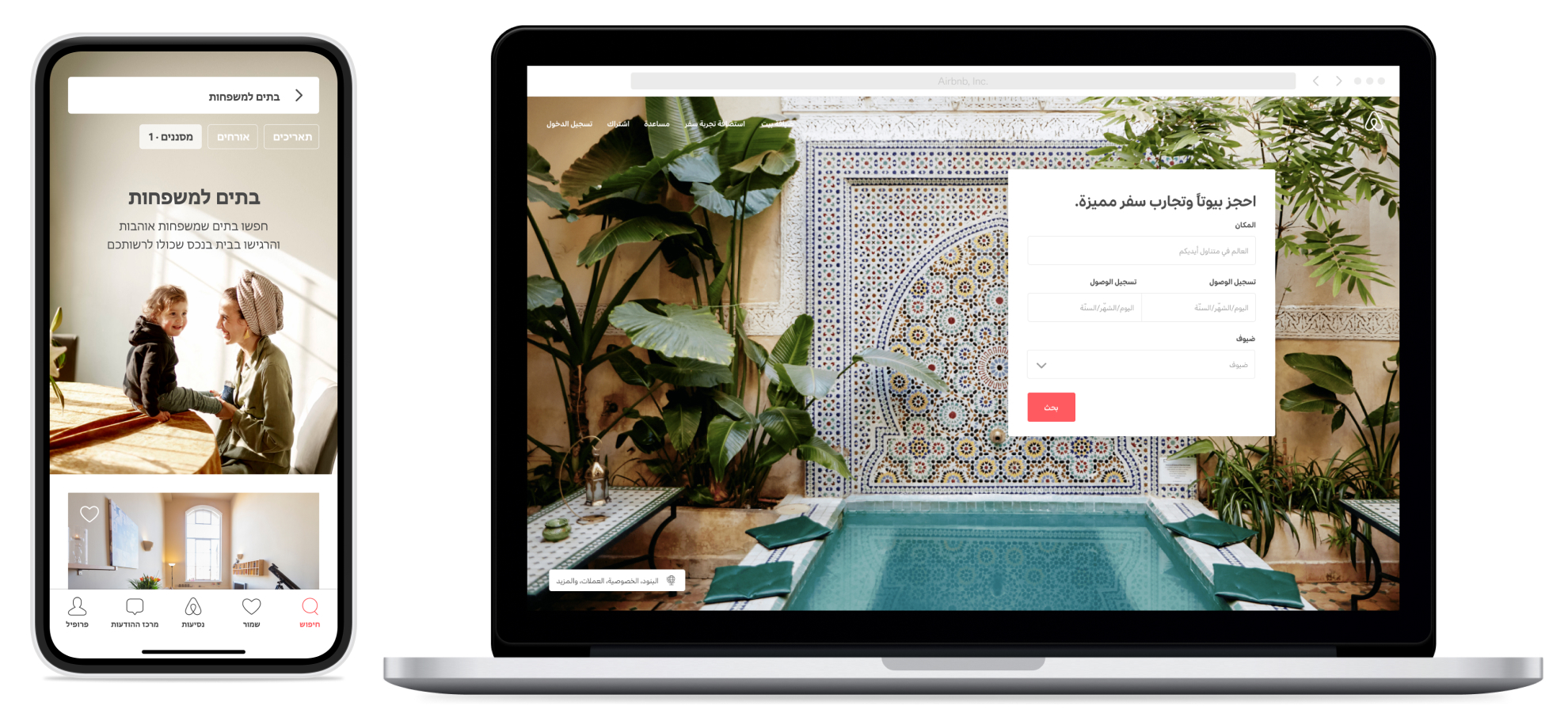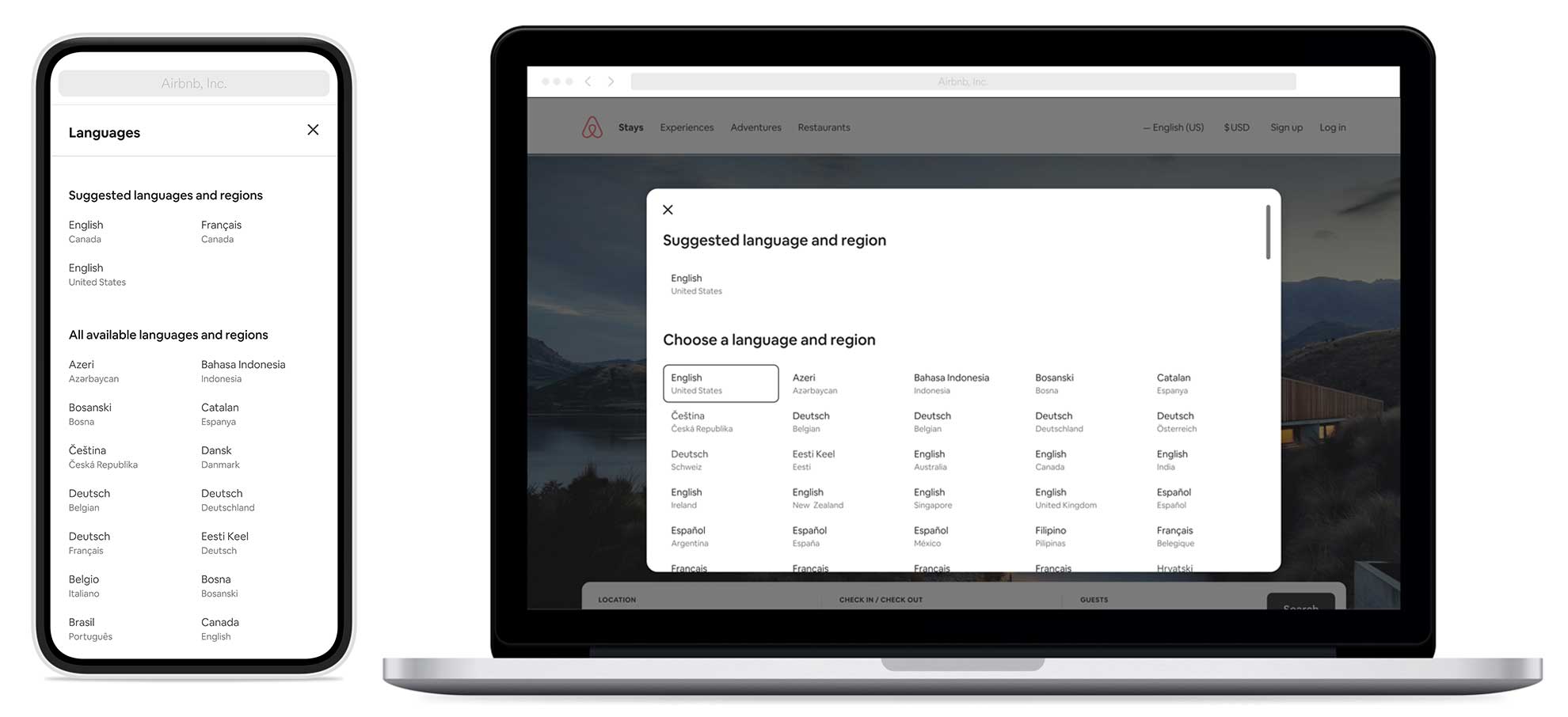Words of Welcome
With 62 supported languages worldwide, Airbnb reaches even more native speakers
In an article published in 2018, Head of Localization Salvatore “Salvo” Giammarresi explained the importance of prioritizing globalization efforts at Airbnb. Now, fresh off the heels of a major localization milestone, we’re revisiting the topic, asking Salvo and Globalization Design Lead Taido Nakajima to fill us in on the tight cross-functional partnership that recently allowed Airbnb to launch 31 new languages across web, iOS, Android, and mobile web, for a total of 62 supported languages. (By doubling that number, Airbnb will now reach over 90% of all online users in their native tongues.)
Here, Salvo and Taido explain how language can be used as a tool for deeper connection, empathy, and growth—and why this launch represents the latest push in the company’s ongoing mission to foster belonging everywhere.
Hi, Salvo and Taido. Can you tell us a bit more about what you do at Airbnb, and what role your teams played in the lead-up to this launch?
Salvo: I am the Head of Localization at Airbnb, leading all Airbnb’s Localization and Globalization initiatives. My team supports all Airbnb’s products and teams. I personally advise all business and functional leaders at all levels, to ensure they are thinking globally in their roles and teams. The Localization team has been the main driver of the Language Expansion Program, which started in Q2 2019 with the launch of Arabic and Hebrew, and now continues with the launch of 31 more languages.
Taido: I’m a Design Lead focused on creating an inclusive community and platform through our initiatives on globalization. My role involves partnering with Salvo and team to build and execute the strategy from a product and design perspective. Prior to this launch, our team was involved with the Arabic and Hebrew language launch, incorporating bidirectional support into our design system by introducing new fonts, typography, and components, while also partnering with our Photography team to capture content that best represented the nuances of different regions’ cultures. Internally, we’ve also established a company-wide learning curriculum and resources with best practices, which empowers Airbnb designers to apply better awareness and methodologies into their processes, ensuring that our company is building thoughtful products with different regional needs in mind.

Airbnb in Hebrew and Arabic.
Salvo, in your previous article about globalization, you explain how your bilingualism has shaped your empathetic approach to cultural and linguistic differences. In what ways has it influenced your involvement in this kind of work, as well?
Salvo: Being an Italian-US English bilingual has shaped my entire life, career, and world view. Being bilingual, and having been exposed to multiple cultures, has helped me develop a unique empathy for the rich linguistic and cultural diversity and affinity that exists across our planet. In my 20+ years working, it’s been refreshing to discover that there are way more similarities than differences between people of all backgrounds. For example, the ways people across the globe feel belonging are remarkably similar. It gives me deep joy to know that with this launch, we will help more people feel that they belong, and feel more connected to fellow hosts and guests around the world.
Tell us more about this exciting new launch.
Salvo: With this language launch, Airbnb is doubling the number of languages we support, for a total of 62 languages covering around 4.3 billion native speakers globally. On average, global high-tech companies support less than 30 languages. By supporting 62, Airbnb will offer more languages—and reach more native speakers—than any other company in the Travel & Hospitality sector.
In addition, we’ve redesigned and repositioned the language and currency selectors, making it easier to choose from the many languages, regions, and currencies we support.
Why is the addition of 31 new languages important to the Airbnb community?
Taido: Imagine you’re looking to book a holiday vacation in a country halfway across the world. If Airbnb doesn’t support your native language, you’re likely to be left navigating the site in a language you may not understand well. You might have trouble conversing with your host to ask if they have a crib for your newborn, or whether the home is located in a quiet neighborhood. The Airbnb host, on the other hand, may struggle to communicate what they have to offer back to you. That’s why this launch is incredibly important. I believe that language understanding is at the core of empathy, and by supporting 62 languages total, we’re aiming to eliminate these kinds of barriers.
Salvo: Before this launch, Airbnb only supported 31 languages despite being available in more than 190 countries. That means in many cases, people couldn’t access our products in their native language. So from a practical perspective, we’re making it easier for hosts and guests to use Airbnb in their preferred languages. In a broader sense, this launch is a historical milestone in the pursuit of our mission, because at Airbnb, we’re striving to create a world where everyone can belong anywhere. By expanding our language coverage, we’re making it easier for more people to belong and to feel at home on Airbnb. Expanding the number of languages we support is our way of being Superhosts to Airbnb’s wider community.

Airbnb Language Selector. The platform now supports 62 languages.
Why was it important to redesign and reposition the language and currency selectors in the process?
Salvo: Our previous language selector wasn’t particularly user-friendly, as it was hidden behind a floating button at the bottom of our pages. The new one is now very visibly on the top menu bar if someone is logged out, and in the user settings when they’re logged in. And now that we support 62 languages, including four variants of English, four variants of Spanish, and two variants of French, we’ve changed the selector to encompass both language and region. This way, hosts and guests can distinguish between Spanish (Spain) or Spanish (Argentina), for example, and as the languages and regions pair, we automatically switch to the currency of that region, enabling all country-specific formats such as dates and phone numbers. Last but not least, to make things even more user-friendly, the language and region selector has a “suggested language and region” section at the top, where we automatically pre-populate language and region suggestions based on each person’s device settings.
What were some challenges you encountered leading up to the launch?
Salvo: Language appears on every product surface, and displaying it correctly across all languages requires linguistic, engineering, and design expertise. Launching 31 new languages demanded constant operational coordination and program management across multiple work streams that involved multiple functions and teams. It truly took a village.
Taido: One of the biggest challenges during this launch was evolving our support from a language to locale basis, where we take into account the unique offerings of a location—its dialects, spelling, currency, formats, cultural nuances, and more. Designing for one locale is difficult enough, but here, we needed to consider 62 unique locales, designing a scalable design system that supports each one and can continue to support newer locales in the future.
One specific challenge was fonts and typesets. Not all writing scripts have a baseline, like Latin. Some, like Chinese, Japanese, and Korean, are based on a bounding box, or, like Devanagari, a topline. This means we need to make sure we think about adjustments of font sizes, weights, line-heights, and even expanding the writing scripts we support. This challenge is ongoing and we’re making progress by working with our Design Language System team to offer better support in the near future.
Walk us through Design’s role in this launch. What critical design aspects go into a language rollout that may surprise a newcomer to the process?
Salvo: Many people may not realize the complexity of properly displaying each language we support across all of our product flows. Our products are very complex and made of a dynamic arrangement of static text, dynamic text that changes based on the person and the specific flow, plus a variety of locale-specific formats, that appear as normal text but are managed by complex algorithms and settings. Getting all this to work properly, so that each surface in each language on each of the four platforms we support is rendered beautifully, entails deep knowledge of engineering, design, operations, linguistics, and cultures.
Taido: Each language rollout affects our entire platform. And I don’t mean just the website or app. It’s everything from communication methods like email and SMS to customer support. Because of this, Design’s main role is to make sure the design decisions we make for each language will scale appropriately to ensure a seamless experience for everyone. To do this, some aspects we obsess over are typesets, iconography, imagery, and the proper formatting of dates, currency, and time. We want to make sure everything is visually represented on our platform to feel “native” and “local” to our hosts and guests.
How did the Design and Globalization teams work together on this?
Salvo: Design was an integral part of the language expansion program. Specifically, design thinking and execution were critical in creating our new language and currency selectors.
Taido: Due to the complexity of this launch, a close partnership between the Design and Globalization team was obviously important. What was just as important was the partnership between us and the rest of the company. The process entailed partnering with multiple teams, including Design Language System, Payments, Policy, and Customer Support, who helped ensure that Airbnb could support the needs of new locales from end-to-end.
What’s the next globalization milestone we can look forward to?
Salvo: In 2020, we plan to go deeper into each market, providing more nuanced localized products and features. We will also consider adding more languages as needed.
Taido: Now that we have a foundation and a system that better supports our global audience, we will focus on localizing our product experience to support the local needs and cultural nuances of specific countries and regions. This includes localizing content, media, photos, illustrations, layouts, and even fonts and typography. In that way, this launch is just the beginning.